
It wasn’t the Joker, Penguin, Catwoman, Riddler, Two-Face, Poison Ivy, Mr. Freeze, or any of their goons that killed the bat: It was the nipples that finally did it. In the space of just eight years, the newly cinematic Batman franchise went from Tim Burton’s enthrallingly dark and twisted vision to a gaudy, pun-filled spectacle that was almost as campy as the Adam West era of the ‘60s – and considerably less fun.
It might have been different if Burton had carried on, but Warner Bros. felt that Batman Returns was too dark. The director stepped aside into a producer role instead so Joel Schumacher (The Lost Boys, Falling Down) could take the series towards the light. Or rather, the dayglo mess that was Batman Forever, with Val Kilmer pouting and grimacing behind the mask.
The tone shifted significantly with the casting and design of the supervillains. Jim Carrey, squeezed into Riddler’s skin-tight green jumpsuit, was at the peak of his gurning self-indulgence while Tommy Lee Jones, apparently with Hubba Bubba stuck to one side of his mug, hammed it up wildly as Two-Face.
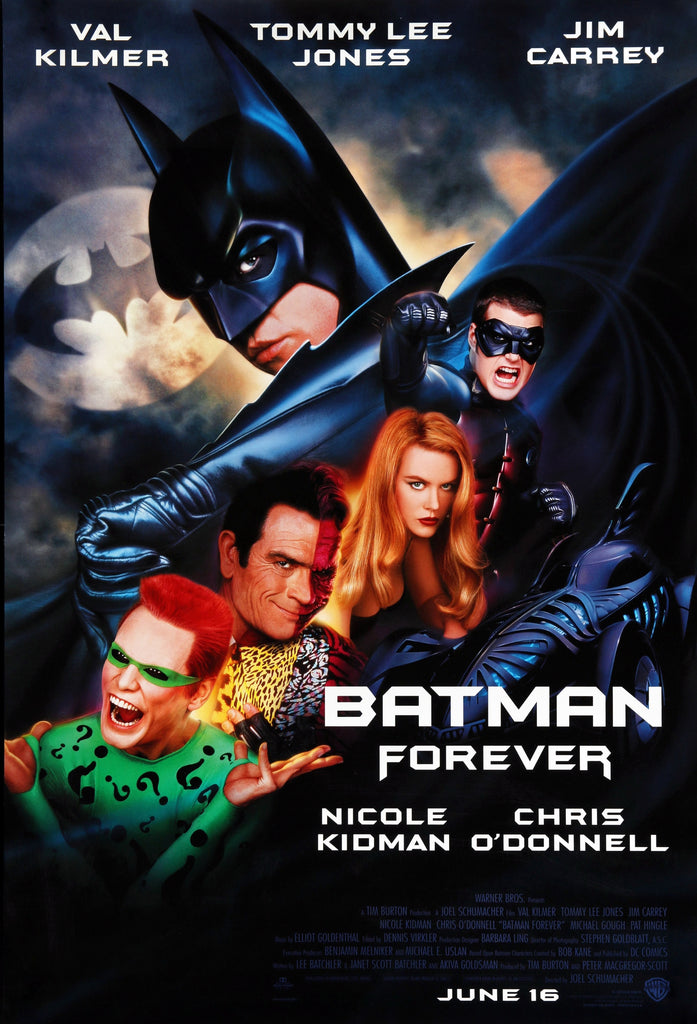
The flashier elements of Schumacher’s movie almost distracted from the contentious decision to design a new batsuit for Kilmer with nipples on the breastplate, inspired by the armour of Roman Centurions. Burton didn’t mince words about it (“Go f**k yourself!”) but it only became a major issue in Batman & Robin, when the nipples became even more perky and were blamed as symptomatic of everything wrong with the film.
Batman & Robin still made a boatload of money but it was the end. The film received 11 Golden Raspberry nominations, winning one: Worst Supporting Actress for Alicia Silverstone as Batgirl, perhaps unfair to single her out in a cast that was mostly dreadful. It is now regarded as one of the worst superhero movies ever made, and George Clooney even felt compelled to apologise to Adam West for his part in the debacle. The franchise was killed off for now, but the bat-pendulum would swing once again towards the gloom and give rise to The Dark Knight Trilogy.
Batman Begins (2005)

Kevin Feige, president of Marvel Studios, took a different stance on Batman & Robin. In 2009, he stated:
“[Batman & Robin] may be the most important comic-book movie ever made. It was so bad that it demanded a new way of doing things. It created the opportunity to do X-Men and Spider-Man, adaptations that respected the source material and adaptations that were not campy.”
This newfound respect also enabled Feige and Marvel to put down a marker with Iron Man (2008), setting into motion the immensely ambitious and obscenely profitable Marvel Cinematic Universe. Yet rivals DC Comics and Warner Bros. were ahead of the game. After Catwoman with Halle Berry stank out theatres in 2004, Christopher Nolan hit the rewind button and went back to the start of Bruce Wayne’s story with Batman Begins.
In 2003, Warner Bros. hired the promising Brit to work on a new Batman project. Nolan had announced himself as a filmmaker of considerable talent with his mind-bending calling card Memento before more impressive work on Insomnia. Now he had the chance to reboot the Batman franchise, and Batman Begins established Nolan as the blockbuster director we know today.
As a fan of Batman comics and graphic novels in his teens, Nolan teamed up with screenwriter David S. Goyer, who had done such distinctive work on Dark City and the first two Blade movies. Their idea was to explore Bruce Wayne’s journey to becoming the Dark Knight and his early days as a crime fighter, much as Casino Royale would with James Bond. Taking their cue from more sombre comic book runs like The Man Who Falls and Batman: Year One, they took a character-driven approach that delved into Wayne’s troubled personality and what drives him to risk his life to save Gotham City.

We always knew that Bruce Wayne was very rich, but Nolan and Goyer’s screenplay was the first cinematic version to fully embrace that fact. Money is his superpower, and the top-secret military tech of Wayne Enterprises provided all those wonderful toys that Jack Nicholson’s Joker might be slavering about. Batman’s gadgets were also grounded in some kind of reality, not least the all-new Batmobile, conceived as a stealthy and robust Tumbler that could give pursuers the slip just as easily as it could smash through a police roadblock.
Casting Bruce Wayne in any new Batman movie is almost as keenly discussed as choosing a new 007, and several actors were in contention for Batman Begins. Henry Cavill, Jake Gyllenhaal, Billy Crudup, Josh Hartnett, Heath Ledger, and Cillian Murphy were all in the frame – needless to say, the latter two still had significant roles to play in Nolan’s trilogy. Instead, the director turned to Christian Bale, who was relatively unknown at the time.
The British actor’s career hadn’t quite taken off the way it was supposed to after his striking breakthrough role in Empire of the Sun. He had re-announced himself to Hollywood by taking a big chance playing Patrick Bateman in American Psycho, a role that many of his friends felt might end his career. The murderous Wall Street yuppie put him back on the map and he had the physique after getting ripped for the part. He showed further action credentials in Reign of Fire and Equilibrium, but it was Bale’s performance in The Machinist that convinced Nolan that he was the right actor to play the haunted billionaire. After losing 62 pounds for the role, he had to bulk up again to play Wayne. Indeed, he went too far, piling on 100 pounds and looking decidedly chubby before cutting back to the required weight for a ninja-trained crime fighter.
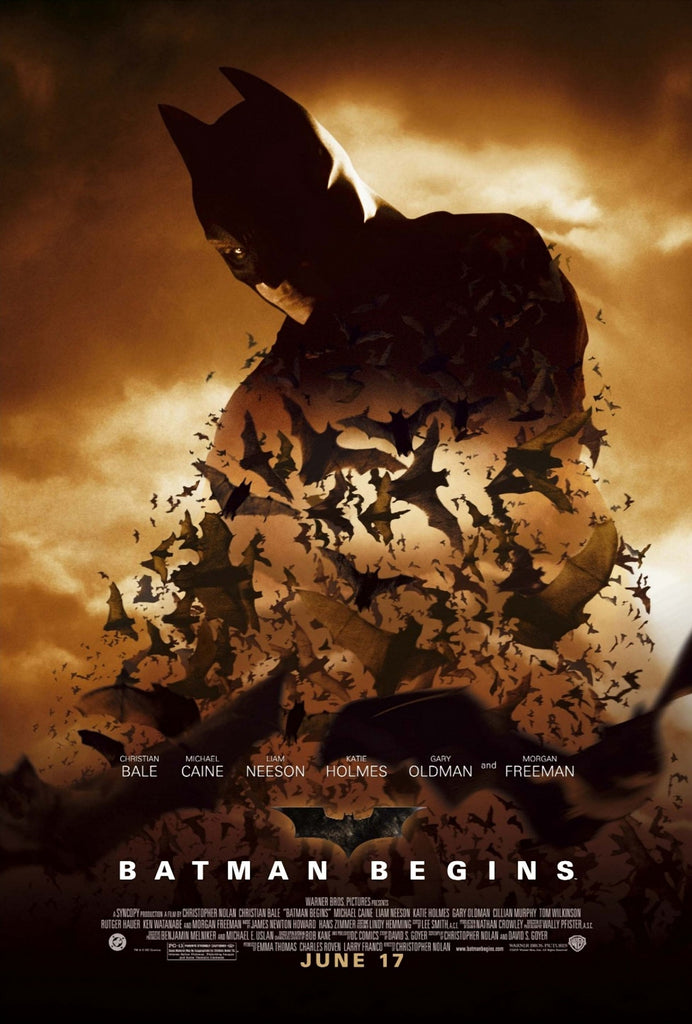
Beyond the critical role of Bruce Wayne, Nolan wanted a stacked cast to give Batman Begins an epic feel. He secured the services of Michael Caine, Gary Oldman, Liam Neeson, Cillian Murphy, Morgan Freeman, Tom Wilkinson, Ken Wantabe, Rutger Hauer, and Katie Holmes. Each would nail their roles, although there were some question marks about how well audiences would react to Holmes due to her relationship with Tom Cruise, who was jumping around on Oprah’s couch and becoming a very vocal mouthpiece for Scientology at the time.
Looking back at it now, Batman Begins is remarkably quiet for a superhero blockbuster. Nolan decided to focus on characters and the relationship between Bruce Wayne and the four men that serve as his mentors: Butler and surrogate father Alfred (Caine), upstanding cop James Gordon (Oldman), tech wizard Lucius Fox (Freeman), and Henri Ducard (Neeson), who trains Wayne for the League of Shadows before revealing how extreme they are prepared to go.
This subdued approach pays dividends as the trilogy progresses, especially with Caine’s twinkly gravitas giving the bond between Wayne and his butler such rich emotional texture. As a spectacle, however, the first film is heavy on mood and strangely low on incident, especially in the first hour as Wayne goes on his journey of discovery without a cape or cowl in sight. Yet it is also the most involving part of the movie because once he actually starts kicking butt as Batman, the film falls a little flat. The reasons are twofold: The villains are small fry and Christopher Nolan can’t direct action to save his life.
Nolan and Goyer picked Scarecrow and R’as Al Ghul because they hadn’t featured in a previous Batman movie or the old TV show. It is clear why in hindsight; although Cillian Murphy and Liam Neeson are both excellent in the roles, they are pretty little league compared to the very best Batman adversaries. For all the film’s attempts at realism, their dastardly plan is also rather old school, a bog-standard fear gas plot that might have come out of the ‘60s Adam West serial.
As for the action, Nolan has now made a career out of making giant blockbusting spectacles that everyone wants to see, but the action beats are often the least interesting parts of his movies. He has improved over the years but Batman Begins shows this aspect of his game at its weakest, with badly edited fights and a completely incomprehensible car chase where it’s impossible to tell which direction anyone is going in, or where they are in relation to one another.
Ultimately, Batman Begins is a sombre and solid movie that might not be held in such high esteem if it had failed at the box office. Despite teasing the arrival of Batman’s greatest foe at the end, Nolan originally intended to make a standalone film in case it wasn’t successful. Yet it was a huge hit, which could mean only one thing: A sequel was required.
The Dark Knight (2008)

Released just two months after the breezy and jovial Iron Man, The Dark Knight was where Christopher Nolan’s approach to Batman really started to look like a master plan. The prospect of Bruce Wayne facing both a new-look Joker and Two-Face was exciting enough, but the major strength of the film is how seriously Nolan treats the material.
More akin to a Michael Mann crime thriller than Tim Burton’s clash between Batman and the Joker, the story starts with a muscular heist sequence and embarks on a series of escalating crises as the Dark Knight’s anarchic archenemy attempts to blow his cover. As the fiendish schemes unfold, the narrative builds unstoppable momentum as it powers toward the final act, convincing us that Gotham truly is trembling in the grasp of a cunning madman. It was one of those rare movies where I genuinely didn’t know what was going to happen next.

Key to this is Heath Ledger’s performance as the Joker and how the story, devised by Nolan with Goyer and developed into a screenplay with his brother Jonathan, treats his character. Believing that previous screen versions of the Clown Prince of Crime just weren’t scary, their goal was to create a truly terrifying Joker. They decided that this would be best achieved by giving him no origin story and making him an unknowable and unpredictable force of mayhem. The result was a captivating presence who is chilling and hilarious in equal measure. Ledger fully inhabits the role and he is virtually unrecognisable beneath the smudged makeup and greasy green hair. He is one of the great screen villains and Ledger was deservedly awarded a posthumous Oscar after the actor tragically passed away aged just 28.
Crucially, The Dark Knight is still immensely compelling even when Ledger isn’t on screen. That’s where the strong casting and the relationships Nolan built in the first film really pay off. When you’ve got actors of the calibre of Michael Caine, Gary Oldman, Morgan Freeman talking, audiences tend to listen. Bale noticeably relaxes into his role this time around and there are more additions: Aaron Eckhart is convincingly cast as Harvey Dent, the swashbuckling District Attorney who will become Two-Face, and Maggie Gyllenhaal is a significant upgrade in the acting stakes as Rachel Dawes, Wayne’s childhood friend and plucky lawyer. The result is a rare superhero movie where we’re not left twiddling our thumbs until the bad guy shows up again, which is always a danger when you have a larger-than-life villain like the Joker.
The Dark Knight has such dramatic heft that it almost has its own gravitational pull, even though the narrative feels a bit disjointed at times. I’ve seen the movie maybe six times and I always find myself completely sucked into the story. The themes of duality may be obvious, but the screenplay handles them with complete sincerity and assurance: Bruce Wayne’s Dark Knight vs Harvey Dent’s White Knight; justice vs vigilantism; integrity vs corruption; luck vs destiny; and, of course, good vs evil, as personified by Batman and the Joker.
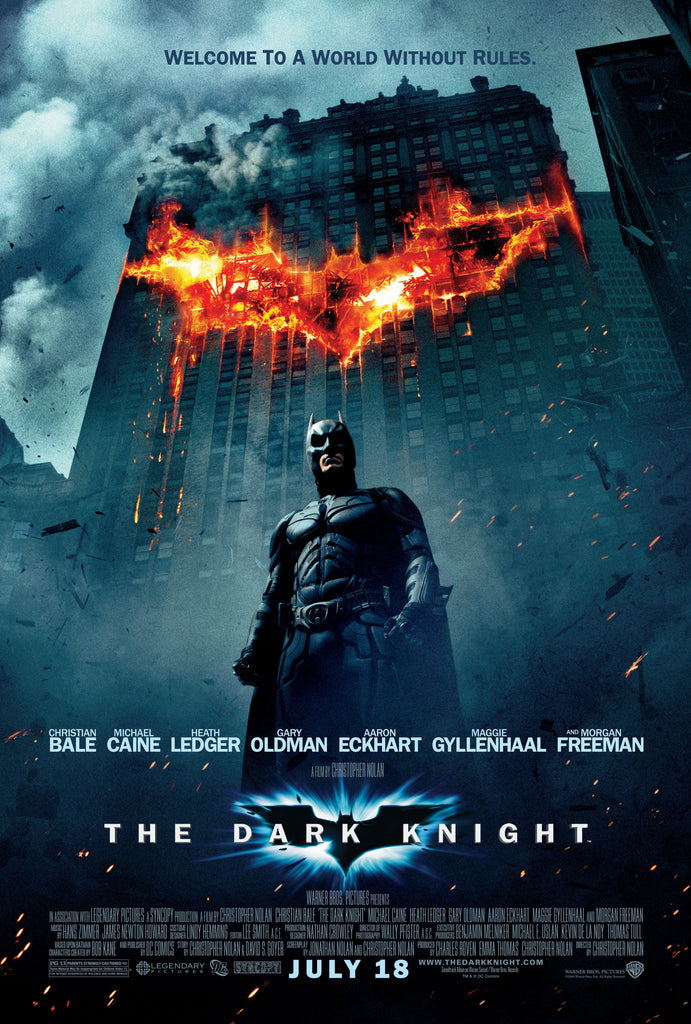
The Joker has always been Batman’s greatest archenemy and they’ve always been two sides of the same coin. The Nolans even go so far as to spell this out for us in the Joker’s final speech without seeming on-the-nose. They are destined to be locked in a battle of wits for eternity, or at least as long as people keep telling stories about Batman. Rather than being heavy-handed, that last speech carries the weight of inevitability, and if Ledger hadn’t passed away we may have seen further outings for his brilliant version of the character. After his death, Ledger’s family stated that the actor had plans to reprise the role.
The Dark Knight may be the strongest film of the trilogy but it is still far from perfect. With more characters to juggle, Bale has less to do apart from pop up at opportune moments to thwart the Joker’s latest move or beat the crap out of him. Eckhart’s Two-Face is a compelling version of the character, but his third-act transformation into the hideously burnt maniac gives him little screen time to really get his teeth into Dent’s fall from grace. And although Nolan delivers some big set pieces, the action is mostly as jumbled the first movie's.
Nevertheless, these are small gripes and the film manages the feat of becoming more than the sum of its considerable parts, leaving us with a poignant and rousing conclusion that sets up the inevitable third film. The Dark Knight performed vastly better than its predecessor at the box office, taking over $1 billion worldwide and receiving eight Oscar nominations. It won two, Ledger for Best Supporting Actor and Best Sound Editing. In a middling field at the Academy Awards where Slumdog Millionaire beat out competition from The Curious Case of Benjamin Button, Frost/Nixon, Milk, and The Reader for Best Picture, a nod for Nolan’s film seems conspicuous by its absence. We’d have to wait until Black Panther for the first superhero movie to receive a nomination for the top award.
The Dark Knight Rises (2012)

How do you top a film as popular and successful as The Dark Knight? The answer is, you can’t, although Christopher Nolan certainly gave it a good shot. We waited four years for the conclusion of the trilogy and, when The Dark Knight Rises finally dropped, we got the equivalent of Return of the Jedi to The Empire Strikes Back — a threequel that tries to wrap up all the loose ends and go bigger, faster, more, but ultimately falls into many people’s rankings as the worst of the bunch.
Although the ending of The Dark Knight clearly sets up Batman’s return for a third film, Nolan was again hesitant before committing. He feared that he would become bored halfway through production if he felt that the project wasn’t up to scratch. Nevertheless, he began working on a third story before making Inception and later signed on to direct again, dismissing any notion that the Joker could be re-cast out of respect for Heath Ledger. He also squelched any suggestions that unused footage of Ledger’s performance might be used in the new film.
Following Ledger was a tough act to follow for anyone. The studio liked the idea of using the Riddler as the antagonist because he was of similar stature to the Joker in the rogue’s gallery of Batman villains. Leonardo DiCaprio was mooted for the role in that eventuality. Nolan preferred Bane, a lesser-known baddie because he was the complete opposite of the mercurial Joker, a hulking monster with a keen and calculating mind. Once that was settled, one of the inspirations for the story was the comic book run Knightfall - the cover for Batman #497 even provided a key image of Bane brutally breaking Batman over his knee.
Having already bulked up to play Charles Bronson (“Britain’s most violent prisoner”) for Nicolas Winding Refn’s Bronson, Tom Hardy had to increase his size even more to play Bane. For the infamous muffled voice, Hardy took inspiration from Bartley Gorman, the bare-knuckle boxer and self-declared “King of the Gypsies.”
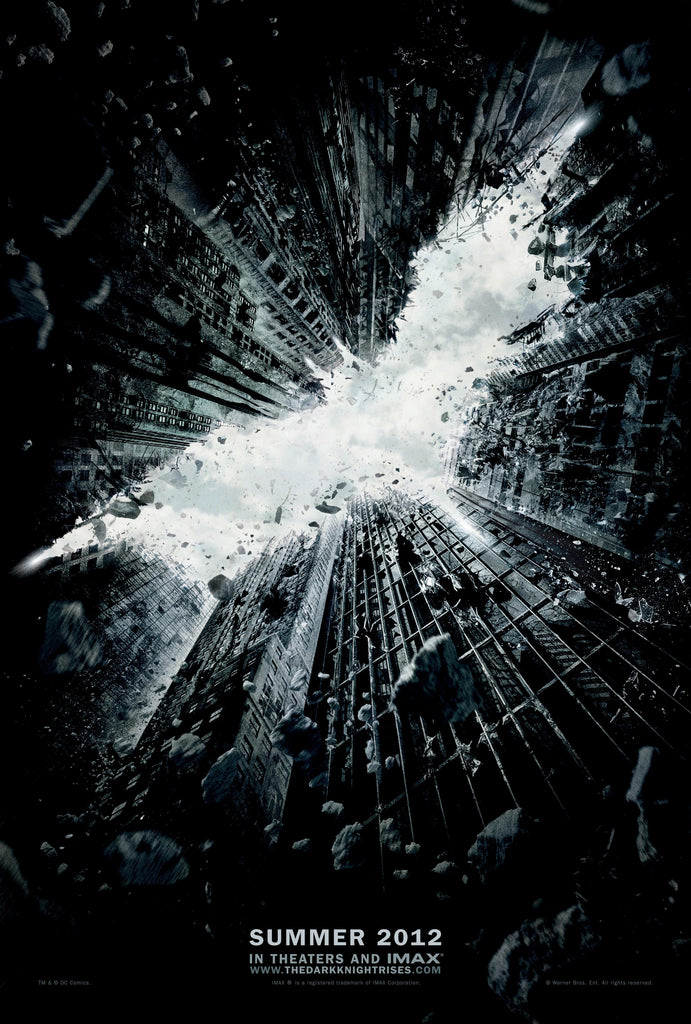
Hardy was joined in the cast by fellow newcomers Anne Hathaway as Selina Kyle, aka, Catwoman; Joseph Gordon-Levitt as the honest cop who would be teased as Robin at the end; and Marion Cotillard as Miranda Tate, competing love interest and CEO of Wayne Enterprises who harbours a dark secret. Further down the line, Nolan added extra quality with the likes of Matthew Modine, Ben Mendelsohn, and Tom Conti. Cillian Murphy reprised his role as Scarecrow, making him another ever-present in the trilogy.
Topping The Dark Knight was a tough ask from the get-go, but Nolan and his team sure tried to give the audience their money’s worth. At 165 minutes long, The Dark Knight Rises is both the longest and most hurried of the trilogy. Nolan knew this was the last hurrah and he had a lot to cram into the running time before the credits rolled. Perhaps he would have been justified in splitting the story over two parts, as has become more the norm nowadays. He certainly had enough narrative and it might have helped some of the plot points settle more smoothly.
Like many people at the time, I was left feeling disappointed by The Dark Knight Rises. Watching it again recently, it still has its flaws but it is a far stronger conclusion to the trilogy than I first gave it credit for. Nolan really swings for the fences as Bane breaks Bruce Wayne financially and physically before taking over Gotham and turning it into a revolutionary state. It’s all a bit rushed and very much of its time, with the supervillain rallying the citizens against the one-percent not long after the financial crisis of 2008.
Bane’s motives and arc aren’t terribly well handled, especially when we reach the final twist revealing that Miranda is the real criminal mastermind and Bane is just a glorified henchman. That’s a pity because, despite the much-lampooned voice, Tom Hardy does a great job of portraying Bane. With his muscular physique, he looks like he could believably overpower Batman in a fistfight and reduce him to a shell of a man dumped in The Pit. Although Hardy is only around 5ft 7, Nolan wisely shoots him from low angles to make him look like a truly daunting presence.
Anne Hathaway’s casting as Catwoman was controversial at the time, provoking the ire of fanboys who didn’t think she was suitable for the role. Even as a non-ravening comic book nerd, she did seem like an underwhelming choice after Michelle Pfieffer totally owned the part in Batman Returns. On a rewatch, she’s actually really good, but I suspect that I know why the geeks didn’t like her. The design of her costume isn’t as lavishly sexualised as Pfieffer’s homemade bondage gear or Halle Berry’s barely-there outfit in Catwoman, calling back instead to the style of Julie Newmar and Lee Meriwether in the ‘60s.
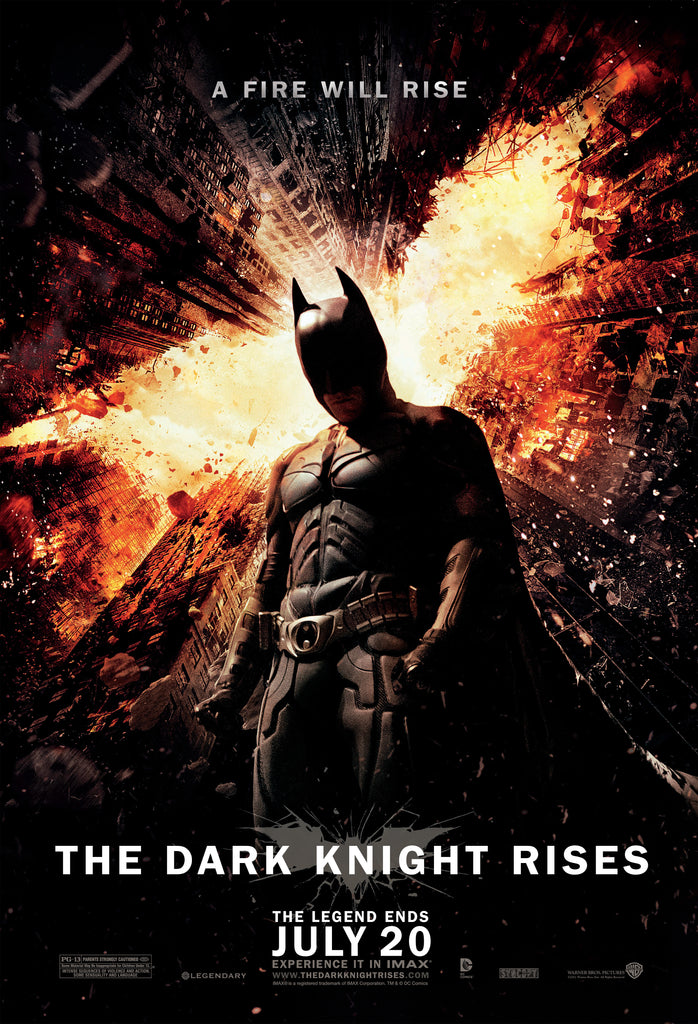
With so much going on in the last act, The Dark Knight Rises careens over the finishing line without pausing for breath. It’s all very breathless, but it still provides a rousing conclusion to an excellent trilogy. If I have one major criticism, it is that we see Alfred making eye contact with Bruce Wayne in that pavement cafe at the end, just as he predicted earlier in the movie. It would have been far more satisfying if Nolan had opted for a little ambiguity, perhaps showing Alfred just looking up, smiling, and then cutting to black.
The Dark Knight Trilogy was a massive success and the middle instalment has already secured third spot in IMDb’s Top 250. Even after 15 years of intense superhero proliferation since, it’s hard to think of many films that top The Dark Knight in either the MCU or DCU. Nolan’s films have also proven incredibly influential to the look and tone of subsequent movies based on DC Comics, opening the gates for Batman vs Superman, The Batman, and Joker to tread an even darker path.
This has stood in stark contrast to the Marvel movies which have largely stuck to quippy popcorn entertainment. Will we eventually reach a point when it becomes all too dark for audiences and the pendulum swings back towards campy and fun once more? Or will someone else come along and find an entirely new direction for Bruce Wayne and his shadowy alter-ego? One thing you can be sure of is that we haven’t seen the last of the Dark Knight, although it remains to be seen whether anyone can better Nolan’s trilogy.
So there you have it, our retrospective on the Dark Knight Trilogy. What is your take on the movies, and which is your favourite instalment? Let us know!




